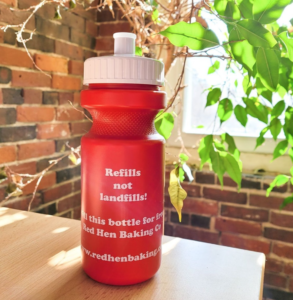 Are you looking for custom water bottles for a work event, sports team, school function, or other occasion? You might notice just how many different options are on the market. There are thousands of different bottle options out there, and you may be wondering: what are water bottles made of? And how do you know which material is right for you?
Are you looking for custom water bottles for a work event, sports team, school function, or other occasion? You might notice just how many different options are on the market. There are thousands of different bottle options out there, and you may be wondering: what are water bottles made of? And how do you know which material is right for you?
We have lots of resources on our website to help you figure out which bottle material is right for you. In this blog post, we’ll break down all the different bottle options, so you know the exact material your favorite bottle is made of! Plus, you’ll be able to navigate all the different water bottle materials on the market.
Tritan – Tritan is a co-polyester first developed by Eastman-Kodak that is used in many items you use every day. It does not contain BPA or BPS (or any bisphenols with similar structures for that matter!). It has all the benefits of a reusable plastic but without those chemicals. In addition to being BPA-free, it’s also a super strong material that is built to last you a long time. It’s shatter resistant, odor resistant, and stain resistant, so it’s great for kids or to just take on the go! It’s also lightweight making it perfect to bring on the go, to school, to the gym, etc. Its dishwasher safe quality makes it super convenient to use for daily activities.
Stainless Steel – Stainless steel is a rust-resistant, food-grade steel that is used in many products today. Stainless steel is an alternative to plastic products in a lot of food and beverage items. It is great for people who try to avoid plastic in their products and/or are worried about chemicals from plastic leeching into their food! Plus, unlike aluminum bottles, stainless steel water bottles do not require a lining in order to be food safe. Stainless steel is also a great option for people who are looking for more sustainable water bottles. First off, reusable water bottles in general are a much more sustainable option than single use plastic water bottles! Stainless steel is a great option because it can actually be recycled, unlike some other materials. In addition, stainless steel bottles last a long time and are quite durable. Even though stainless-steel water bottles are recyclable, we do not sell recycled stainless steel water bottles because it’s impossible to confirm whether or not the steel came into contact with materials that are not food safe.
Glass – Glass is used in a wide variety of products, and for good reason! It’s 100% recyclable and is non-toxic. It can be recycled over and over without loss in quality, making it the perfect option for people looking for a sustainably made water bottle. It’s a great option for those looking to avoid plastic for health or sustainability reasons. Glass is impermeable to liquids, meaning nothing will leach into your water or drink! It’s a great choice for food storage in addition to glass water bottles, because you don’t have to worry about chemicals leaching into food or drinks when heat is present.
Aluminum – Aluminum is an affordable but durable option for water bottles. Our aluminum water bottles feature quality construction and a wide variety of colors! Because aluminum reacts with certain liquids, aluminum water bottles must be lined–typically with an enamel, resin, polymer, or epoxy. All of our aluminum water bottles have BPA-free, food-grade liners. BPA-free aluminum bottles are lower-cost alternatives to trendy stainless steel, and they are lighter than stainless bottles. They have a higher perceived value than plastic water bottles which is great if you’re on a budget!
These are some of the most popular water bottle materials on the market. We hope this helps you as you’re shopping around for your perfect bottle! If you need more assistance figuring out which material is right for you, then reach out to our team today or browse our blog to find other helpful posts regarding this topic! We’re standing by to answer all of your questions.
